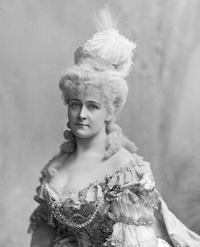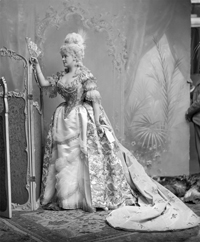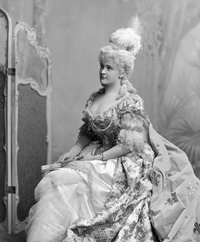Frances Evelyn (Daisy), Countess of Warwick,
One of the central characters of the late Victorian and Edwardian eras, the Countess of Warwick was the most glamorous English aristocrat and chatelaine of the suitably romantic Warwick Castle.
Known to all society as one of the “most tempestuous and most fascinating of the Prince of Wales’s great ladies” and one of the fastest women in the “fast set”, she led a carefree life until her own Bal Poudré in 1895 when she was criticised in print for her extravagance and lack of philanthropy. Although at first incensed by the article, Daisy shortly became converted to socialism and it was said that “her… advocacy of the redistribution of property was backed by long experience in the redistribution of spouses.” The Duchess of Connaught in 1904 wrote that Lady Warwick was the most complete Edwardian even though she did not maintain the tradition of discretion and “danced outside the pale.” For the Ball, Daisy personified Marie Antoinette, daughter of Marie Theresa and Francis I of Austria. As the spouse of Louis XVI, she followed him to the guillotine in 1793. The sangfroid with which she approached her own death inspired many poetic homages. Her costume, made by Worth of Paris according to the Countess’s own memoirs was, paradoxically ascribed to Mrs Mason of Burlington Street at the time of its first outing at the Duchess’s now famous 1895 ball. The shape and import of the outfit appear to represent perfectly the allegation of the Victorian sexologist Havelock Ellis that the corset’s aim was to “furnish woman with a method of heightening at once her two chief secondary sexual characteristics, the bosom above and the hips and buttocks below.”
The costume consisted of a bodice and paniers of pink and gold flowered brocade and gold lace studded with silver sequins and diamonds. The square-cut neck was trimmed with old lace, and the chiffon sleeves were divided into small puffs with gold lace sparkling with jewels. The front of the bodice was festooned with diamond rivières. The train of turquoise velvet was lined with gold and sequin lace and embroidered at equal distances with raised gold fleur-de-lis. In her coiffure poudrée, the countess wears a diamond kokoshnik tiara holding ostrich and aigrette feathers. The effect of this costume had been noted by The Queen in 1895: “The Countess wore the family jewels, and fairly blazed with diamonds” The costume appears to be modelled on a drawing by Elizabeth Vigée Le Brun entitled “La reine Marie Antoinette dans le parc de Versailles” (1780). These two images are dated 20 July 1897 and were made at the Lafayette studio. In the full-length portraits, the studio assistant’s hand can be seen to the far right of the photograph, holding the Rococo-style painted backdrop taught. |
Click on image to enlarge Click on image to enlarge
|
||||||
|
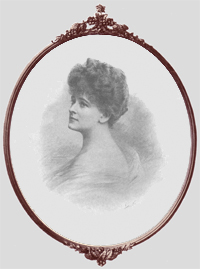
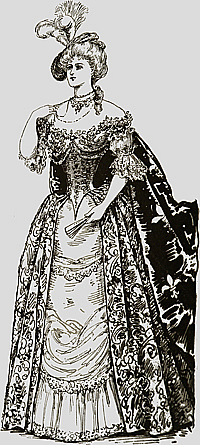

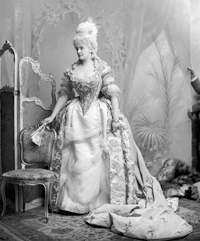 V&A Lafayette Archive
V&A Lafayette Archive